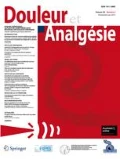Résumé
Cette étude a pour objectif de valider en français un questionnaire qui mesure l’impact fonctionnel: Pediatric Migraine Disability Assessment (PedMIDAS). Le PedMIDAS est composé de six questions qui évaluent le retentissement des céphalées sur la vie de tous les jours. Soixantetreize enfants ont pris part à cette étude. Ce questionnaire montre une fiabilité satisfaisante (α = 0,76), une bonne stabilité temporelle (corrélation test–retest = 0,85) et de nombreuses corrélations avec les caractéristiques des céphalées, les troubles émotionnels et la qualité de vie.
Abstract
The aim of this paper is to validate a French version of the Pediatric Migraine Disability Assessment (Ped- MIDAS). The PedMIDAS is a six-question tool that assesses the disability caused by headaches in school-age children and adolescents. A total of 73 participants completed the questionnaire. Overall, the questionnaire has a good internal consistency (α = 0.76), test–retest reliability (0.85), and several correlations with headache characteristics, emotional disorders, and quality of life.
Références
Abu-Arafeh I, Razak S, Sivaraman B, Graham C (2010) Prevalence of headache and migraine in children and adolescents: a systematic review of population-based studies. Dev Med Child Neurol 52:1088–97
Balottin U, Fusar-Poli P, Termine C, et al (2013) Psychopathological symptoms in child and adolescent migraine and tensiontype headache: a meta-analysis. Cephalalgia 33:112–22
Bellini B, Arruda M, Cescut A, et al (2013) Headache and comorbidity in children and adolescents. J Headache Pain 14:79
Kernick D, Reinhold D, Campbell JL (2009) Impact of headache on young people in a school population. Br J Gen Pract 59:678–81
Palermo TM (2000) Impact of recurrent and chronic pain on child and family daily functioning: a critical review of the literature. J Dev Behav Pediatr 21:58–69
McGrath PJ, Walco GA, Turk DC, et al (2008) Core outcome domains and measures for pediatric acute and chronic/recurrent pain clinical trials: PedIMMPACT recommendations. J Pain 9:771–83
World Health Organization (2007) International classification of functioning, disability and health: Children & youth version. ICFCY, Genève
Stewart WF, Lipton RB, Kolodner K, et al (1999) Reliability of the migraine disability assessment score in a population-based sample of headache sufferers. Cephalalgia 19:107–14
Stewart WF, Lipton RB, Dowson AJ, Sawyer J (2001) Development and testing of the Migraine Disability Assessment (MIDAS) Questionnaire to assess headache-related disability. Neurology 56:S20–S8
Hershey AD, Powers SW, Vockell AL, et al (2001) PedMIDAS: development of a questionnaire to assess disability of migraines in children. Neurology 57:2034–9
Hershey AD, Powers SW, Vockell ALB, et al (2004) Development of a patient-based grading scale for PedMIDAS. Cephalalgia 24:844–9
Topcu Y, Hiz-Kurul S, Bayram E, et al (2014) The paediatric migraine disability assessment score is a useful tool for evaluating prophylactic migraine treatment. Acta Paediatr 103:e484–e9
Rapoff MA, Connelly M, Bickel JL, et al (2014) Headstrong intervention for pediatric migraine headache: a randomized clinical trial. J Headache Pain 15:12
Kröner-Herwig B, Heinrich M, Vath N (2010) The assessment of disability in children and adolescents with headache: adopting PedMIDAS in an epidemiological study. Eur J Pain 14:951–8
Magnoux E, Freeman M, Zlotnik G (2008) MIDAS and HIT-6 French translation: reliability and correlation between tests. Cephalalgia 28:26–34
Sousa VD, Rojjanasrirat W (2011) Translation, adaptation and validation of instruments or scales for use in cross-cultural health care research: a clear and user-friendly guideline. J Eval Clin Pract 17:268–74
Vallerand RJ (1989) Vers une méthodologie de validation transculturelle de questionnaires psychologiques: implications pour la recherche en langue française. Can Psychol 30:662–80
Headache Classification Subcommittee of the International Headache Society (2004) The international classification of headache disorders: 2nd edition. Cephalalgia 24:9–160
Goodman R (1997) The Strengths and Difficulties Questionnaire: a research note. J Child Psychol Psychiatry 38:581–6
Simeoni MC, Auquier P, Antoniotti S, et al (2000) Validation of a French health-related quality of life instrument for adolescents: the VSP-A. Qual Life Res 9:393–403
R Development Core Team (2015) R: a language and environment for statistical computing. Vienna, Austria
Öztop DB, Tasdelen BI, PoyrazogLu HG, et al (2016) Assessment of psychopathology and quality of life in children and adolescents with migraine. J Child Neurol 31:837–42
Ferracini GN, Dach F, Speciali JG (2014) Quality of life and health-related disability in children with migraine. Headache 54:325–34
Fuh JL, Wang SJ, Lu SR, et al (2010) Headache disability among adolescents: a student population-based study. Headache 50:210–8
Slater SK, Kashikar-Zuck SM, Allen JR, et al (2012) Psychiatric comorbidity in pediatric chronic daily headache. Cephalalgia 32:1116–22
Senturk A, Alpaslan B, Uygunoglu U, et al (2014) Evaluation of headache prevalence and characteristics in orphans aged 12–17. J Headache Pain 15:B34
Author information
Authors and Affiliations
Corresponding author
About this article
Cite this article
Amouroux, R., Rousseau-Salvador, C., Pillant, M. et al. Validation française du PedMIDAS, une échelle d’évaluation de l’impact fonctionnel des migraines chez l’enfant et l’adolescent. Douleur analg 30, 92–98 (2017). https://doi.org/10.1007/s11724-017-0502-7
Received:
Accepted:
Published:
Issue Date:
DOI: https://doi.org/10.1007/s11724-017-0502-7

